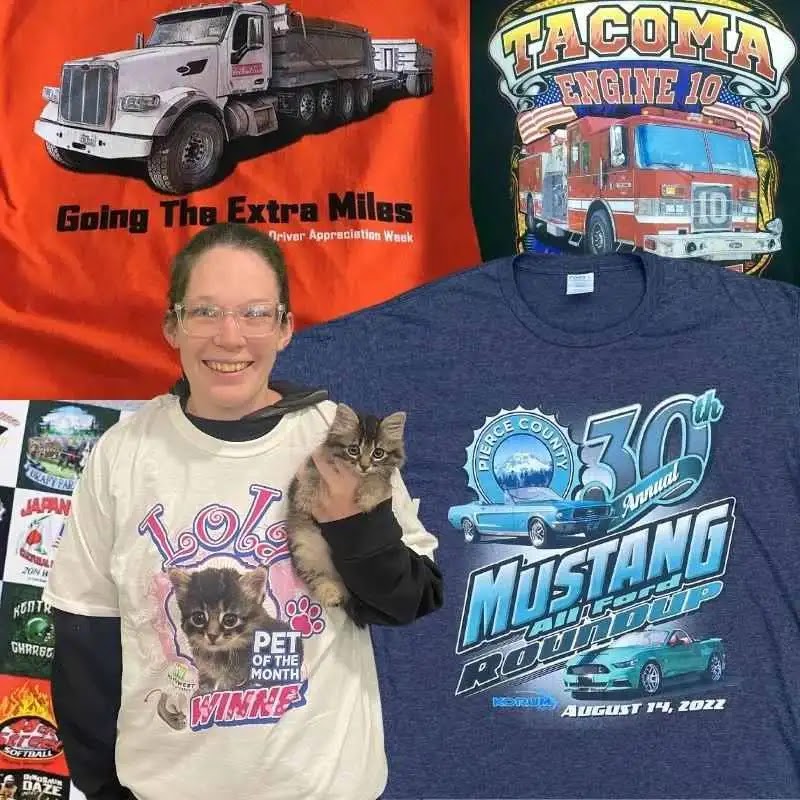Direct to Garment Printing: This is not the Same as Screen Printing
In the realm of apparel customization, two prevalent methods stand out: Direct to Garment (DTG) printing and Screen Printing. While both techniques aim to imprint designs onto fabric, their processes, outcomes, and applications significantly differ, catering to diverse preferences in the market.
Understanding Direct to Garment (DTG) Printing
DTG printing is a cutting-edge method that involves printing digital designs directly onto fabric using specialized inkjet technology. The process resembles printing on paper, but instead, it utilizes fabric-friendly inks. This method allows for intricate designs with multiple colors and gradients, replicating the digital artwork faithfully onto clothing.
Advantages of DTG Printing
Vibrant Color Reproduction: DTG excels in reproducing intricate designs with a wide spectrum of colors, ensuring high-quality prints with fine details.
Ideal for Small Batch Production: Its digital nature makes DTG printing cost-effective for small orders, eliminating the need for screen setups.
Versatility in Design: Complex designs, photographs, and detailed artwork can be accurately reproduced with DTG, offering unparalleled versatility.
Limitations of DTG Printing
Material Constraints: Works best on 100% cotton or cotton-blend fabrics, affecting the choice of materials for printing.
Not Economical for Bulk Orders: While suitable for smaller quantities, DTG printing becomes less cost-efficient for large-scale production runs.
Unveiling Screen Printing
Screen Printing, on the other hand, employs a more traditional approach involving stencils or screens to transfer ink onto fabric. Each color in the design requires a separate screen, limiting the complexity of multicolored designs compared to DTG printing.
Advantages of Screen Printing
Cost-Efficiency for Bulk Orders: Screen Printing becomes more economical for large volumes of identical designs due to lower per-unit costs.
Suitable for Various Fabrics: Works well on various fabrics, including cotton, polyester, and blends, offering versatility in material choices.
Long-Lasting Prints: The ink used in Screen Printing often results in more durable prints, making it ideal for items subjected to frequent washing.
Limitations of Screen Printing
Complexity Constraints: Intricate designs with fine details and gradients might not be accurately reproduced due to the limitations of screen setups.
Higher Setup Costs: Initial setup costs involving screens for each color can be relatively high, impacting the feasibility of smaller orders.
Making the Right Choice
When choosing between DTG and Screen Printing, consider factors like design complexity, fabric type, order quantity, and budget constraints. DTG shines for small orders with intricate designs, while Screen Printing excels in cost-efficiency for large-scale production runs with simpler designs.
In conclusion, understanding the distinctions between DTG and Screen Printing is pivotal for making informed decisions in apparel customization. Each method offers unique advantages and limitations, catering to varying preferences and requirements within the industry. The choice ultimately depends on the specific needs of your project, whether it's intricate designs on smaller batches or cost-effective mass production with simpler artwork.
DTG Printing Becomes Less Cost-Efficient for Large-Scale Production
Direct to Garment (DTG) printing revolutionized apparel customization, offering unmatched versatility and quality for smaller orders. However, as production scales up, certain limitations come to light, impacting its cost-efficiency in large-scale operations.
The Intricacies of DTG Printing
DTG printing involves the direct application of ink onto fabric using specialized inkjet technology, allowing for intricate designs with multiple colors and gradients. Its digital nature eliminates the need for screen setups, making it ideal for smaller batch production with diverse designs.
Advantages of DTG Printing for Small Orders
Design Complexity: DTG excels in reproducing complex designs, detailed artwork, and photographs with vibrant colors and fine details.
Versatility: It offers flexibility in printing various designs without incurring high setup costs, making it suitable for smaller quantities.
Quality and Detail: The technology allows for high-resolution prints, maintaining the integrity of the original design.
Limitations in Large-Scale DTG Production
As production volumes increase, the advantages of DTG printing begin to diminish due to several inherent limitations.
Impact of Order Quantity
Time-Consuming Process: DTG printing is time-consuming, especially for larger quantities, as each garment requires individual printing, impacting overall production speed.
Increased Costs: Despite its efficiency in small batches, the cost per unit rises significantly for larger orders due to higher ink consumption and longer production times.
Material and Fabric Constraints
Limited Fabric Compatibility: DTG works best on 100% cotton or cotton-blend fabrics, restricting material choices for large-scale orders.
Washing and Durability: Prints may not withstand frequent washings as effectively as screen-printed counterparts, impacting long-term durability.
The Cost Dynamics at Scale
While DTG printing offers unparalleled quality and versatility for smaller orders, its cost-effectiveness diminishes as production scales up. Factors such as time, material constraints, and ink consumption significantly impact the overall cost per unit, making it less favorable for larger volumes.
Alternative Options for Large-Scale Production
For businesses focusing on large-scale production on Nw Custom Apparel, alternative methods like Screen Printing or Heat Transfer Printing might present more cost-effective solutions.
Exploring Screen Printing
Screen Printing, although less versatile in design complexity, excels in large-scale orders due to its cost efficiency.
Economies of Scale: Screen Printing becomes more cost-effective as the order volume increases due to lower setup and production costs.
Durability and Wash Resistance: The ink used in Screen Printing often results in more durable prints, suitable for items subjected to frequent washing.
Considerations for Large-Scale Operations
When considering large-scale production, it's essential to weigh the pros and cons of each printing method against the specific requirements of the project. While DTG printing offers unparalleled quality for smaller batches, alternative methods like Screen Printing may provide more economical solutions for high-volume orders.
Conclusion
While DTG printing stands out for its versatility and high-quality output in smaller orders, its cost-efficiency diminishes as production scales up. Understanding the limitations of DTG at larger volumes is crucial for businesses aiming for cost-effective solutions in high-volume apparel production. Consideration of alternative printing methods becomes pivotal in balancing quality and cost-effectiveness for large-scale operations.

Comments
Post a Comment